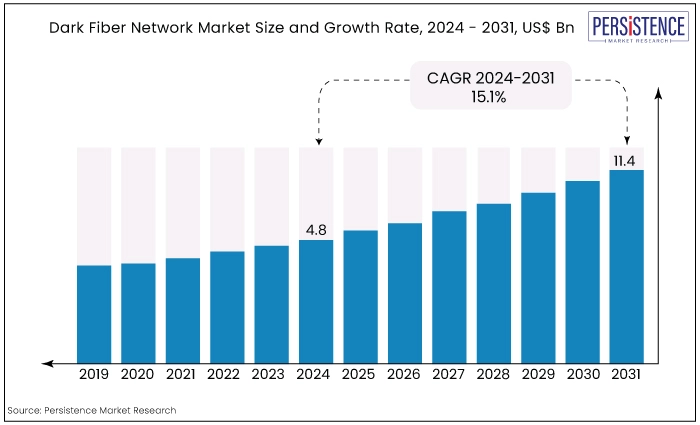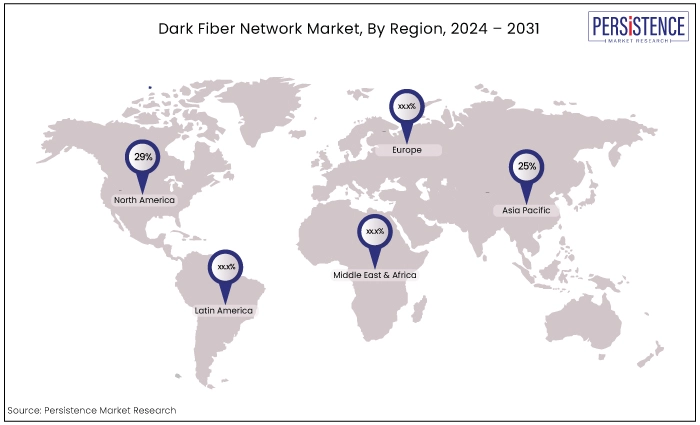Industry: IT and Telecommunication
Published Date: July-2024
Format: PPT*, PDF, EXCEL
Delivery Timelines: Contact Sales
Number of Pages: 231
Report ID: PMRREP34691
The market for dark fiber network is estimated to reach a valuation of US$11.4 Bn by the year 2031, at a CAGR of 15.1%, during the forecast period 2024 to 2031.
Key Highlights of the Market
|
Market Size (2024) |
US$4.8 bn |
|
Projected Market Value (2031) |
US$11.4 bn |
|
Forecast Growth Rate (CAGR 2024 to 2031) |
15.1% |
|
Historical Growth Rate (CAGR 2019 to 2023) |
6.3% |
The dark fiber network market is projected to experience significant expansion in the future due to rapid technological advancements and a boom in global internet usage.
Dark or unlit fiber refers to fiber optic lines that have been installed by carriers or network service providers but are not currently operational. These can be installed underground or underwater and are established utilizing either point-to-point or point-to-multipoint arrangements.
Dark fiber networks offer numerous benefits, including superior internet performance, exceptionally fast internet speeds, enhanced optical fiber bandwidth, and a highly secure network.

Rising Demand for High-Speed Internet and Bandwidth
One of the most significant drivers of the dark fiber network market is the increasing demand for high-speed internet and bandwidth.
As businesses and consumers rely more heavily on cloud services, video streaming, and online gaming, the need for robust and high-capacity networks has surged.
Dark fiber networks, which are essentially unused optical fibers that can be leased to enterprises and service providers, offer the ability to handle vast amounts of data at high speeds with minimal latency.
This capacity is crucial for supporting the data-intensive applications and services that are becoming standard in both personal and professional settings.
Proliferation of Data Centers
The exponential growth of data generation and storage needs has led to the proliferation of data centers worldwide. These facilities require high-performance and reliable connectivity to manage the large volumes of data traffic efficiently.
Dark fiber networks provide a scalable and flexible solution for data centers, enabling them to connect with each other and with customers at high speeds.
The ability to control their own infrastructure, optimize performance, and expand capacity as needed makes dark fiber an attractive option for data center operators. This market trend is particularly pronounced in industries such as finance, healthcare, and e-commerce, where data security and speed are paramount.
Growing Adoption of 5G Technology
The deployment of 5G technology is another critical driver of the dark fiber network market. 5G promises to deliver significantly faster speeds, lower latency, and higher connectivity compared to its predecessors. However, to realize these benefits, 5G networks require a dense fiber optic infrastructure to support the massive increase in data transmission.
Dark fiber networks are ideally suited to meet these requirements, providing the necessary backhaul to support the small cell sites and towers that form the backbone of 5G networks. As 5G continues to roll out globally, the demand for dark fiber is expected to grow correspondingly.
High Initial Cost of Deploying Dark Fiber Networks
One of the most substantial barriers to the growth of the dark fiber network market is the high initial cost associated with deploying dark fiber infrastructure.
Deploying dark fiber networks requires significant capital investment in infrastructure. This involves the costs of laying fiber optic cables, acquiring rights-of-way, and installing necessary equipment.
These expenses are particularly high in urban areas where existing infrastructure might need to be upgraded or replaced. The cost of digging trenches, installing conduits, and laying fiber can be prohibitive, especially for smaller companies or those operating in less densely populated areas.
In addition to the initial deployment costs, maintaining and operating a dark fiber network requires ongoing investment. This includes the costs of monitoring the network, repairing any damages, and upgrading equipment to keep pace with technological advancements.
Ensuring network reliability and performance can be costly, particularly in regions with harsh environmental conditions or high risk of physical disruptions.
The substantial upfront investment in dark fiber networks presents a financial risk, as the return on investment (ROI) may take several years to materialize. This long payback period can deter potential investors and companies from entering the market.
The uncertainty around demand and future technological developments can also contribute to hesitancy, as companies may fear that their investments could become obsolete before they achieve significant returns.
Advancements in Technology
As technology advances, the capabilities of fiber optic networks are continually being enhanced. Innovations such as Dense Wavelength Division Multiplexing (DWDM), and Coarse Wavelength Division Multiplexing (CWDM) allow for more data to be transmitted over a single fiber by using different wavelengths (or colors) of light.
This dramatically increases the capacity of existing fiber networks without the need for laying new fiber, providing a cost-effective way to scale up infrastructure.
The integration of AI and machine learning into network management offers significant opportunities. These technologies can optimize network performance, predict maintenance needs, and enhance security by detecting and responding to threats in real-time. AI-driven automation can also streamline network operations, reducing costs and improving efficiency.
Increasing Demand for High-Speed Internet and Bandwidth
The growing consumption of video streaming, online gaming, and other bandwidth-intensive applications is driving demand for high-speed internet.
Dark fiber networks can meet this demand by providing the high capacity and low latency required for seamless user experiences. This trend is expected to continue, especially with the proliferation of 4K and 8K video content, virtual reality, and augmented reality applications.
The COVID-19 pandemic has accelerated the adoption of remote work and digital transformation across industries. Businesses are increasingly reliant on robust and high-speed internet connections to support remote employees, cloud services, and virtual collaboration tools.
Dark fiber networks offer the necessary infrastructure to support these trends, providing reliable and high-capacity connectivity.
Multi Mode Fiber Represents Nearly 62% Market Share
|
Market Segment by Fiber Type |
Market Value Share 2023 |
|
Multi Mode |
62% |
Based on fiber type, the global dark fiber network market is further segmented into single mode and multi mode, where the multi mode segment dominates the market.
It is also predicted to continue ruling the market over the projection period. This type is best suited for short transmission distances. It is typically utilized in video surveillance and Local-area Network (LAN) systems.
Single-mode fiber, on the other hand, is best suited for greater transmission distances. It is largely utilized in multi-channel television broadcast systems and long-distance telephone. The single-mode category is likely to show remarkable increase throughout the projected timeframe.
This product type is utilized for long-distance installations ranging from 2 meters to 10,000 meters. It delivers lower power loss in contrast to multi-mode. However, it is expensive than multi-mode fibers.
Long Haul Network Type Spearheads with 55% of Global Market Revenue
|
Market Segment by Network Type |
Market Value Share 2023 |
|
Long Haul |
55% |
Based on network type, the global dark fiber network market is further divided into metro and long haul network, where the long haul network segment dominates the market.
Long-haul segment is predicted to exhibit the highest growth rate over the period. The sector continues to gather momentum due to its capacity to connect over great distances at low signal intensity.
Such long-haul terrestrial networks are commonly employed in submarine cabling across great oceanic distances, thereby attracting the participation of various businesses in terms of investments.
For instance, in October 2021, Zayo Group, LLC has built three new long-haul dark fiber routes from Denver to Salt Lake City, Atlanta to Dallas, and Eugene to Reedsport.
The expansion of the long-haul network is propelled by ongoing investments, the advancement of intelligent urban areas, and intense competitive forces in the market.
North American region dominates the global market with 29% of the total market share.
|
Region |
Market Value Share 2023 |
|
North America |
29% |
North America dominated the dark fiber network market in 2023, accounting for around 29% of the total revenue. The United States is currently making significant investments in the construction of 5G network infrastructure.
The nation's substantial investments in intelligent residences, advanced industries, and urban initiatives are expected to bolster the expansion of the local market during the projected timeframe.
The governments of developed nations, like the United States, the United Kingdom, Germany, China, and Japan, are making significant investments in security infrastructure within their respective countries. The fast emerging economies are becoming increasingly aware of the need to enhance their global influence.
The Asia Pacific region is expected to experience the highest rate of growth during the forecast period. Full stop. The Asia Pacific region is leading in terms of revenue growth because to technological improvements and widespread acceptance of the technology in the IT, telecommunication, and administrative sectors.
The regional market grip is being strengthened by the widespread adoption of technology in the industrial sector and the growth of the IT and telecom sectors in the Asia Pacific area.
Furthermore, the growing utilization of fiber networks in the healthcare industry is driving rapid growth in nations like China, Japan, and India, leading to a substantial increase in overall demand.

The global dark fiber network market is characterized by intense competition among a diverse set of players, ranging from established telecommunications giants to emerging infrastructure providers.
The competitive landscape is influenced by factors such as technological advancements, geographic reach, service offerings, and strategic partnerships. The global market is highly competitive, with players adopting various strategies to enhance their market position.
Telecommunications giants leverage their extensive infrastructure and financial resources, specialized providers focus on expertise and customization, and regional players capitalize on local market knowledge.
Continuous network expansion, strategic partnerships, and a strong focus on customer service are key factors driving competitiveness in this dynamic market.
Recent Industry Developments
July 2023
Zayo Group, LLC introduced several improvements to its fiber network infrastructure. These encompass enhancements in the fiber capacity of existing routes, the establishment of innovative long-haul dark fiber routes, the introduction of new Internet Protocol (IP) points of presence (PoPs), and the integration of additional routes enabled with 400 Gbps.
January 2023
Summit Infrastructure Group established a specialized and completely subterranean dense dark fiber network in Columbus, Ohio. This network was designed to cater to the expanding data center and enterprise sectors in the area.
June 2022
Bandwidth Infrastructure Group introduced their premium dark fiber network in the Greater Portland area. The company's dark fiber networking solutions are currently expanding within the rapidly developing region.
|
Attributes |
Details |
|
Forecast Period |
2024 – 2031 |
|
Historical Data Available for |
2019 – 2023 |
|
Market Analysis |
US$ Billion for Value |
|
Key Regions Covered |
|
|
Key Companies Profiled |
|
|
Pricing |
Available upon request |
By Fiber Type
By Network Type
By Material
By Application
By Region
To know more about delivery timeline for this report Contact Sales

The global dark fiber network market is estimated to exhibit a CAGR of 15.1% during the forecast period.
North America is the leading region in the market.
The market is segmented based on network type, fiber type, material and application.
AT&T Inc., Colt Technology Services Group Limited, Comcast Corporation, Consolidated Communications, and GTT Communications, Inc. are some of the major key companies in the market.
Multi mode segment is the dominant fiber type.